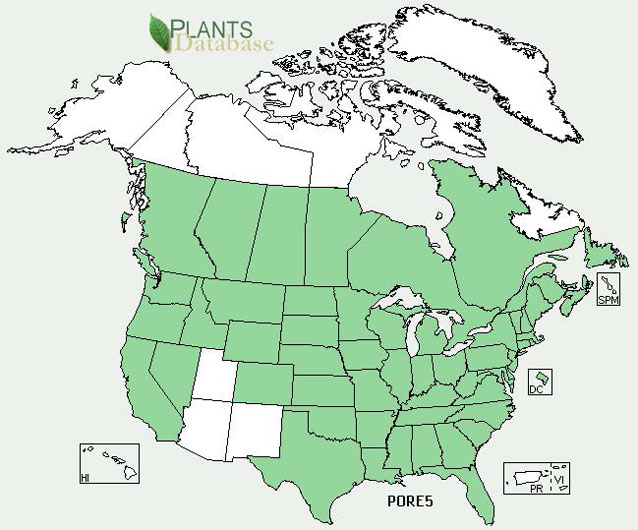Rosaceae (Rose family)
At a Glance

© Carla Hoopes / Montana State Noxious Weed Awareness and Education Program
- Perennial
- 8 to 30 stems per plant
- Shiny, erect hairs arise at right angles to the stems.
- Leaves alternate and palmately compound
- Pale yellow flowers occur in branched inflorescences at the ends of the stems.
- Fruit is an achene with a netted pattern covering the surface.
Habitat and Ecology
Native to the eastern Mediterranean, sulfur cinquefoil (Potentilla recta) was introduced to North America before 1900 and is now well established throughout much of the United States and Canada, particularly in the inland areas of the Pacific Northwest. Sulfur cinquefoil establishes in a variety of ecosystems, and in the West, it is able to invade undisturbed grasslands, shrublands, and open forests. It also invades disturbed sites, such as roadsides, abandoned fields, and areas with heavy livestock grazing. Because of the high tannin content of its leaves and stems, livestock tend to avoid eating it. Sulfur cinquefoil may hybridize with native cinquefoils.

USDA
Description
Sulfur cinquefoil is a perennial herb whose stems are covered with shiny, erect hairs at right angles to the stem. Reaching 8 to 30 inches in height, sulfur cinquefoil has one to eight stems arising from a woody base. Below the woody base is a single taproot with several shallow, spreading lateral roots. The plant grows new shoots from this woody base in early spring and the flowering stems begin to grow in May. Although new shoots can grow from the base, sulfur cinquefoil reproduces by seeds that are dispersed by the wind. Long-distance dispersal can occur via animal fur, clothing, and vehicles.

Ohio State Weed Lab Archive / OSU
Leaves
The leaves are alternate and shaped like a palm with five to nine leaflets per leaf. The leaves have serrated edges and are covered with sparse, stiff hairs.
Flowers and Fruits
The pale yellow flowers occur in a branched inflorescence that is almost flat-topped. Each inflorescence can have from one to 60 flowers. The flowers have five petals, each with a notch in the center of the tip. Sulfur cinquefoil flowers from early May to July.
The fruit is an achene (a dry fruit with a single seed and thin walls that does not open at maturity; for example, a sunflower “seed”). These achenes are shaped like commas and are dark brown with a netted pattern covering the surface.
Etymology

© Steve Hurst
Potentilla is a diminutive of the Latin word potens, which means powerful. The genus name reflects the strong astringent properties of some species. The species epithet “recta” means upright.
Similar Species
Sulfur cinquefoil can be confused with native cinquefoils, but it can be distinguished by its three unique characteristics: 1) long hairs perpendicular to the stem, 2) many stem leaves but few basal leaves, and 3) a net-like pattern on its seed coat.
Control Methods
Possible control methods are explained at these websites:
References
Endress, B. A., and C. G. Parks. 2004. Potentilla recta in Element Stewardship Abstracts. The Nature Conservancy, Arlington, VA.
Charters, M. L. 2009. California plant names: Latin and Greek meanings and derivations. Available at http://www.calflora.net/botanicalnames (accessed 12 April 2010).
Natural Resources Conservation Service. 2007. Ecology and management of sulfur cinquefoil (Potentilla recta L.). Invasive Species Technical Note No. MT-17. United States Department of Agriculture, Montana State Office, Bozeman, MT.
Zouhar, K. 2003. Potentilla recta in Fire Effects Information System. US Department of Agriculture, Forest Service, Rocky Mountain Research Station, Fire Sciences Laboratory. Available at http://www.feis-crs.org/feis/ (accessed 12 April 2010).
Prepared by Kelly Reeves, Southern Colorado Plateau Network Inventory and Monitoring Program, 2010.
Last updated: June 28, 2016
